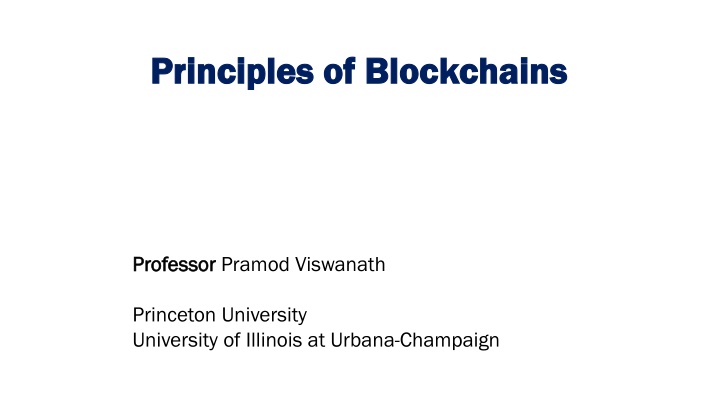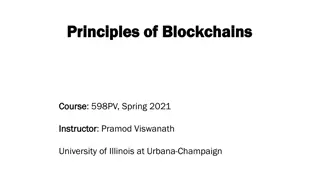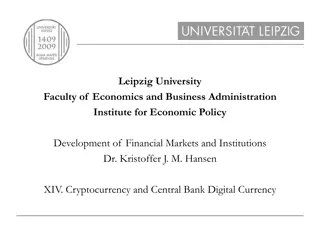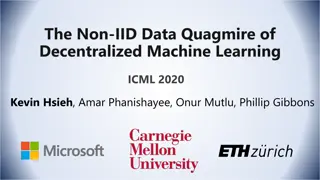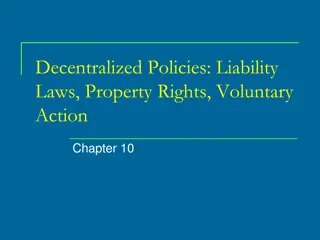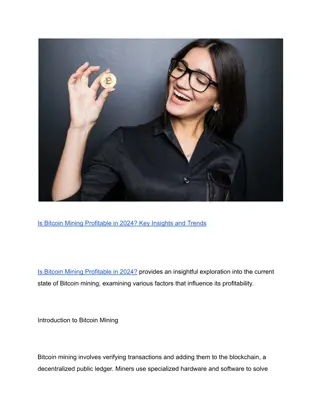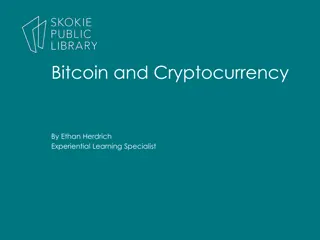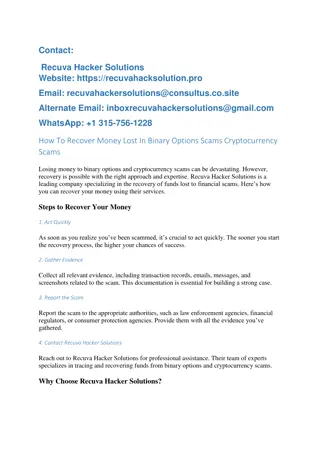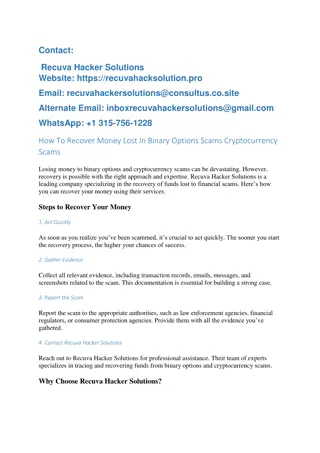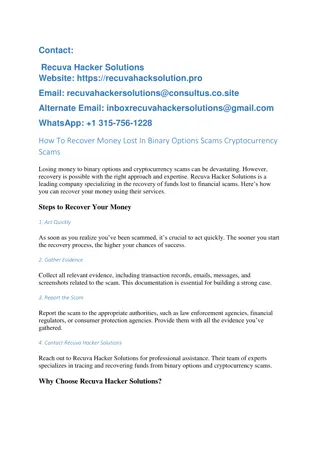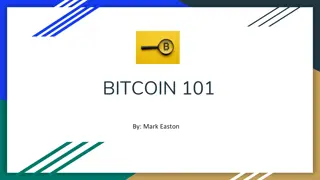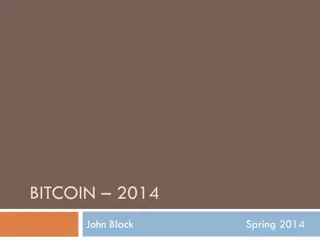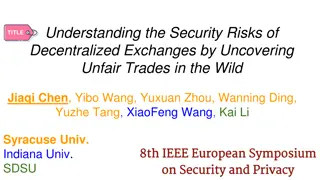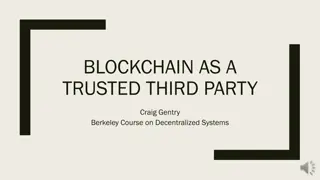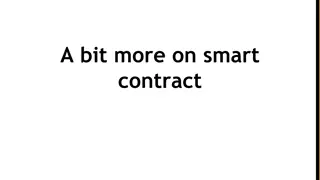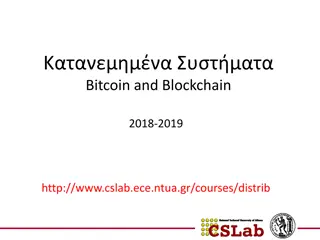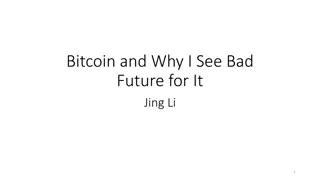Decentralized Platforms and Bitcoin Insights
In the digital realm, blockchains serve as decentralized trust platforms, enabling flexible cooperation and facilitating a platform economy. Explore the principles behind blockchains, the evolution of trust, and the impact of decentralized platforms like Bitcoin. Gain insights into the original blockchain, its role in the cryptocurrency landscape, and key performance metrics that define its security and efficiency.
Download Presentation

Please find below an Image/Link to download the presentation.
The content on the website is provided AS IS for your information and personal use only. It may not be sold, licensed, or shared on other websites without obtaining consent from the author.If you encounter any issues during the download, it is possible that the publisher has removed the file from their server.
You are allowed to download the files provided on this website for personal or commercial use, subject to the condition that they are used lawfully. All files are the property of their respective owners.
The content on the website is provided AS IS for your information and personal use only. It may not be sold, licensed, or shared on other websites without obtaining consent from the author.
E N D
Presentation Transcript
Principles of Blockchains Principles of Blockchains Professor Professor Pramod Viswanath Princeton University University of Illinois at Urbana-Champaign
What are Blockchains? What are Blockchains? Blockchains are decentralized digital trust platforms Blockchains are decentralized digital trust platforms This is a mouthful, so let us unpack it.
Trust Trust Human success is based on flexible cooperation in large numbers. This requires trust Evolution of Trust over human history
Platform Economy Platform Economy 2021 (year end) Top US companies by market cap 2011 Top US companies by market cap 1. Apple $2740 B 1. Exxon $417 B 2. Microsoft $2280 B 2. Apple $321 B 3. Alphabet $1826 B 3. Chevron $215 B 4. Amazon $1612 B 4. Microsoft $213 B 5. Tesla $1042 B 5. IBM $207 B 6. Facebook $889 B 6. Walmart $204 B
A Decentralized Platform? A Decentralized Platform? A decentralized Dropbox, eBay, Instagram? Incentives aligned with consumers and resource providers? No need for a trusted middle party? Such is the siren song of blockchains.
Bitcoin: the original blockchain Bitcoin: the original blockchain Cryptocurrency Cryptocurrency medium of exchange and store of value Born during the 2008 Financial Crisis 2008 Financial Crisis Anonymous inventor Anonymous inventor pseudonym: Satoshi Nakamoto Very secure Very secure no attacks, has been live continuously
Bitcoin and Bubbles Bitcoin and Bubbles
Bitcoin performance Bitcoin performance 1. Security 50% adversary 2. Transaction throughput 7 tx/s 3. Confirmation Latency hours 4. Energy consumption medium size country 5. Compute specialized mining hardware 6. Storage everyone stores everything 7. Communication everyone tx/rx everything
Bitcoin is far from a Platform Bitcoin is far from a Platform 1M Trades / Sec Exchanges 100K Tx / Sec IoT 10K Tx / Sec 10K Tweet / Sec Social Networks 1000 Tx / Sec Payments Gaming assets Prediction Market 1000 Tx / Sec Ethereum: 20 Tx / Sec Core Blockchain Infrastructure Throughput
Building Block of Blockchains Building Block of Blockchains Platforms are applications built on networked computers Basic building block: Decentralized Computer 1. Multiple untrusted computers interacting with one another, forming consensus on an ordered list of instructions 2. A virtual machine interprets the instruction set 3. A programming language and a corresponding compiler provide a forum for decentralized applications (dApps)
Technical Components Technical Components Decentralized Computer Cryptographic data structures Disk I/O and Database management Memory management Operating systems Peer to peer networking Consensus and distributed algorithms Virtual Machine Reduced instruction set, incentives General purpose programming language Turing complete, compatible with trust-free execution environments Smart Contract Prog. Language Virtual Machine Decentralized Consensus Nearly all aspects of Computer Science
Principles of Blockchains Principles of Blockchains This course presents the design space of blockchains Principles of good blockchain design choices Full-stack view Pre-requisite: maturity with nearly all aspects of computer science Concretely: basic background in algorithms, systems programming
Course begins with Bitcoin Course begins with Bitcoin We start with an in-depth view of the Bitcoin design The focus allows us to see the interacting components of the blockchain Highlight the design constraints across the layers Bitcoin design is very simple and yet remarkably secure, elegant in an engineering sense performance guarantees backed by sophisticated mathematics Outstanding case study for a deep understanding of blockchains
Module 1. Bitcoin Blockchain Module 1. Bitcoin Blockchain Next four lectures: Cryptographic data structures, Consensus, Peer to Peer Networking, Transaction structure, Ledger state management Two lectures: mathematical security guarantees of Bitcoin Implementation-intensive: students implement a full-stack Bitcoin client
Module 2. Scaling Blockchain Module 2. Scaling Blockchain Adapting the Bitcoin design to scale its performance Scaling: Throughput Latency Computation, Storage Energy Layer 2 scaling via sidechains The resulting blockchain designs are at the heart of many popular cryptocurrency platforms: Avalanche, Cardano, Solana, Polygon
Module 3. Beyond Bitcoin Module 3. Beyond Bitcoin Incorporating features absent in the Bitcoin design The resulting blockchain designs are at the heart of many popular cryptocurrency platforms: Zcash, ChainLink, 1. Finality 2. Privacy 3. Connecting blockchains: Bridges 4. Importing data into blockchains: Oracles
Module 4: Applications and Module 4: Applications and dApps dApps 1. 1. Smart Contract Ecosystem Smart Contract Ecosystem 2. 2. Decentralized Finance ( Decentralized Finance (DeFi DeFi) ) 3. 3. Digital Collectibles (NFT) Digital Collectibles (NFT) Focus: Focus: 1. 1. Principles Principles: : programmable, permissionless, friction-free revolution in the application arenas of finance and collectibles. 2. 2. Hands-on instruction: students implement basic dApps for both DeFi and NFT applications in the Solidity programming language
Logistics: course content Logistics: course content Website for the course Website for the course: https://courses.grainger.illinois.edu/ece598pv/sp2022/ Assignments and Projects on Gitlab Assignments and Projects on Gitlab: https://gitlab.engr.illinois.edu/ece598pv/ece598pv-sp2022 Communication Communication: Instruction from staff via email Students can post on Piazza, Discord and Gitlab
Logistics: programming language Logistics: programming language Rust Rust
What is Rust? What is Rust? Rust is a compiled language just like C/C++. Rust code is compiled to executable binary. Rust program is highly reliable. Rust s type system and ownership model guarantee memory-safety and thread-safety. Programmers eliminate many classes of bugs at compile-time, where the compiler message is highly useful to eliminate bugs and make the program more reliable. www.rust-lang.org
Miner User Interface NOT ALLOWED Add new transactions Get transactions Memory Pool Transaction 1 Transaction 2 ... Rust compiler doesn t allow more than one owner (Miner & UI) of an object (Memory Pool).
Miner User Interface Add new transactions Get transactions Thread Thread- -safe lock safe lock Pass compiling and safe Memory Pool Transaction 1 ... If an object is wrapped by a thread-safe lock, Rust compiler allows more than one owner (Miner & UI).
Besides its reliability, Rust also provides Besides its reliability, Rust also provides good ... good ... efficiency as C/C++, network support as Go and Python, functional-style programming as Scala, community support as many other popular lanuages.
Why is Rust chosen for blockchains? Why is Rust chosen for blockchains? High reliability makes blockchains reliable and secure. Good efficiency makes blockchains scalable. Network support makes communication easy-to-code. Influential blockchain projects are using Rust:
Logistics: programming language Logistics: programming language Solidity Solidity
What is What is Solidity Solidity? ? Solidity is an object-oriented, high-level language for implementing smart contracts. Smart contracts are programs which govern the behavior of accounts within the Ethereum state. Solidity is designed to target the Ethereum Virtual Machine (EVM). Solidity is statically typed, like Java, C, Rust unlike python or javascript.
A Simple Smart Contract A Simple Smart Contract
MPs using Solidity MPs using Solidity Interact with Etheruem blockchain - Mint your own tokens (like ETH / CryptoKitties) - Create decentralized market maker (like Uniswap) -
